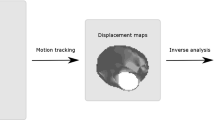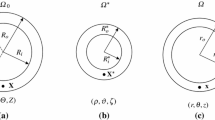Abstract
Computational models of diseased arteries are advancing rapidly, and a need exists to develop more accurate material models of human atherosclerotic plaques. However, intact samples for in vitro mechanical testing are not readily available. Most plaque samples are harvested from carotid endarterectomies where the geometries are not suitable for the boundary parameters necessary for classical uniaxial tensile testing. Experimental studies of biological tissue, particularly human plaque tissue, have not specified the minimum width-to-length (WL) ratio necessary for appropriate tensile testing. This study proposes either tensile or planar shear testing on whole specimen samples depending on the WL ratio. However, a “grey-area” of WL ratios exists which are unsuitable for either test, between 0.5:1 and 4:1 WL ratio. Eighteen plaque samples are investigated in this study, and according to classical approaches, two of the plaque samples have WL ratios suitable for tensile testing and four are suitable for planar shear testing. The remaining twelve samples fall in the grey-area of WL ratio. The study analyses which test method is suitable for the samples in this grey-area and what effect using the incorrect test method has on results from a computational model. The study highlights that tissues above a WL ratio of 2:1 are suitable for planar shear testing, and samples below 1:1 are more suited for tensile testing. Therefore, the “grey-area” can be reduced with certain limitations applied by the minor strain assumption which need to be taken into account during experimental testing. This study also demonstrates the influence of curve-fitting experimental results using tensile- and planar shear–based boundary parameters from eighteen plaque samples.













Similar content being viewed by others
References
Akyildiz A, Speelman L, van Brummelen H, Gutierrez M, Virmani R, van der Lugt A, van der Steen A, Wentzel J, Gijsen F (2011) Effects of intima stiffness and plaque morphology on peak cap stress. Biomed Eng Online 10(1):1–13
ASTM-International (2009). E8 standard test methods for tension testing of metallic materials, vol. 3.01. ASTM International. West Conshohocken, PA
Auricchio F, Conti M, De Beule M, De Santis G, Verhegghe B (2011) Carotid artery stenting simulation: from patient-specific images to finite element analysis. Med Eng Phys 33(3):281–289
Beattie XuC, Vito R, Glagov S, Whang CM (1998) Mechanical analysis of heterogeneous, atherosclerotic human aorta, vol 120. American Society of Mechanical Engineers, New York
Borschel GH, Kia KF, Dennis RG (2003) Mechanical properties of acellular peripheral nerve. J Surg Res 114(2):133–139
Cilla M, Pena E, Martinez M (2012) 3d computational parametric analysis of eccentric atheroma plaque: influence of axial and circumferential residual stresses. Biomech Model Mechanobiol 11(7): 1001–1013
Creane A, Maher E, Sultan S, Hynes N, Kelly DJ, Lally C (2010) Finite element modelling of diseased carotid bifurcations generated from in vivo computerised tomographic angiography. Comput Biol Med 40(4):419–429
Cui F, Han HC, Zhang YW (2010) Mechanical performance study of vascular stent using computational modeling and simulation 6th world congress of biomechanics (WCB 2010). August 1–6, 2010 Singapore, IFMBE proceedings, vol 31. Springer, Berlin, pp 1443–1446
Davis JR (2004) Tensile testing, 2nd edn. ASM International, Materials Park, Ohio
Delfino A, Stergiopulos N, Moore JE, Meister JJ (1997) Residual strain effects on the stress field in a thick wall finite element model of the human carotid bifurcation. J Biomech 30(8):777–786
Di Martino E, Mantero S, Inzoli F, Melissano G, Astore D, Chiesa R, Fumero R (1998) Biomechanics of abdominal aortic aneurysm in the presence of endoluminal thrombus: experimental characterisation and structural static computational analysis. Eur J Vasc Endovasc Surg 15(4):290–299
Franquet A, Avril S, Le Riche R, Badel P (2011) Identification of heterogeneous elastic properties in stenosed arteries: a numerical plane strain study. Comput Methods Biomech Biomed Eng 15(1):49–58
Gao H, Long Q, Graves M, Gillard JH, Li ZY (2009) Carotid arterial plaque stress analysis using fluid-structure interactive simulation based on in-vivo magnetic resonance images of four patients. J Biomech 42(10):1416–1423
Gasser TC, Ogden RW, Holzapfel GA (2006) Hyperelastic modelling of arterial layers with distributed collagen fibre orientations. J R Soc Interface 3(6):15–35
Guinea GV, Atienza JM, Rojo FJ, Garciaa-Herrera CM, Yiqun L, Claes E, Goicolea JM, Garciaa-Montero C, Burgos RL, Goicolea FJ, Elices M (2010) Factors influencing the mechanical behaviour of healthy human descending thoracic aorta. Physiol Meas 31(12):1553–1565
Guyton A (1991) Textbook of medical physiology, 8th edn. W.B. Saunders, Philadelphia
Hanuza J, Maczka M, Gasior-Glogowska M, Komorowska M, Kobielarz M, Bedzinski R, Szotek S, Maksymowicz K, Hermanowicz K (2010) Ft-raman spectroscopic study of thoracic aortic wall subjected to uniaxial stress. J Raman Spectrosc 41(10):1163–1169
Herisson F, Heymann MF, Chetiveaux M, Charrier C, Battaglia S, Pilet P, Rouillon T, Krempf M, Lemarchand P, Heymann D, Goueffic Y (2011) Carotid and femoral atherosclerotic plaques show different morphology. Atherosclerosis 216(2):348–354
Hollenstein M, Ehret A, Itskov M, Mazza E (2011) A novel experimental procedure based on pure shear testing of dermatome-cut samples applied to porcine skin. Biomech Model Mechanobiol 10(5):651–661
Holzapfel G, Gasser T, Ogden R (2000) A new constitutive framework for arterial wall mechanics and a comparative study of material models. J Elast 61(1):1–48
Holzapfel GA, Sommer G, Regitnig P (2004) Anisotropic mechanical properties of tissue components in human atherosclerotic plaques. J Biomech Eng 126(5):657–665, research support, Non-US Gov’t, In Vitro
Huang H, Virmani R, Younis H, Burke AP, Kamm RD, Lee RT (2001) The impact of calcification on the biomechanical stability of atherosclerotic plaques. Circulation 103(8):1051–1056
Kiousis DE, Rubinigg SF, Auer M, Holzapfel GA (2009) A methodology to analyze changes in lipid core and calcification onto fibrous cap vulnerability: the human atherosclerotic carotid bifurcation as an illustratory example. J Biomech Eng 131(12):121,002
Krejza J, Arkuszewski M, Kasner SE, Weigele J, Ustymowicz A, Hurst RW, Cucchiara BL, Messe SR (2006) Carotid artery diameter in men and women and the relation to body and neck size. Stroke 37(4):1103–1105
Lally C, Reid AJ, Prendergast PJ (2004) Elastic behavior of porcine coronary artery tissue under uniaxial and equibiaxial tension. Ann Biomed Eng 32(10):1355–1364
Lawlor MG, O’Donnell MR, O’Connell BM, Walsh MT (2011) Experimental determination of circumferential properties of fresh carotid artery plaques. J Biomech 44(9):1709–1715
Lendon CL, Davies MJ, Richardson PD, Born GVR (1993) Testing of small connective tissue specimens for the determination of the mechanical behaviour of atherosclerotic plaques. J Biomed Eng 15(1):27–33
Li ZY, Tang T, U-King-Im J, Graves M, Sutcliffe M, Gillard JH (2008) Assessment of carotid plaque vulnerability using structural and geometrical determinants. Circ J Off J Jpn Circ Soc 72(7):1092–1099
Loree HM, Grodzinsky AJ, Park SY, Gibson LJ, Lee RT (1994a) Static circumferential tangential modulus of human atherosclerotic tissue. J Biomech 27(2):195–204
Loree HM, Tobias BJ, Gibson LJ, Kamm RD, Small DM, Lee RT (1994b) Mechanical properties of model atherosclerotic lesion lipid pools. Arterioscler Thromb Vasc Biol 14(2):230–234
Maher E, Creane A, Sultan S, Hynes N, Lally C, Kelly DJ (2009) Tensile and compressive properties of fresh human carotid atherosclerotic plaques. J Biomech 42(16):2760–2767
Medtech-Insight (2011) US markets for peripheral vascular stents report. Technical report 254, Medtech insight
Palmieri G, Chiappini G, Sasso M, Papalini S (2009) Hyperelastic materials characterization by planar tension tests and full-field strain measurement. Annu Conf Soc Exp Mech 1:1–4
Paraskevas KI, Mikhailidis DP, Veith FJ (2009) Carotid artery stenting may be losing the battle against carotid endarterectomy for the management of symptomatic carotid artery stenosis, but the jury is still out. Vascular 17(4):183–189
Raghavan M, Webster M, Vorp D (1996) Ex vivo biomechanical behavior of abdominal aortic aneurysm: assessment using a new mathematical model. Ann Biomed Eng 24(5):573–582
Richardson PD (2002) Biomechanics of plaque rupture: progress, problems, and new frontiers. Ann Biomed Eng 30(4):524–536
Roffi M, Mukherjee D, Clair DG (2009) Carotid artery stenting vs. endarterectomy. Eur Heart J 30(22):2693–2704
Scherer S, Treichel T, Ritter N, Triebel G, Drossel W, Burgert O (2011) Surgical stent planning: simulation parameter study for models based on dicom standards. Int J Comput Assist Radiol Surg 6(3):319–327
Silver FH, Snowhill PB, Foran DJ (2003) Mechanical behavior of vessel wall: a comparative study of aorta, vena cava, and carotid artery. Ann Biomed Eng 31(7):793–803
Stemper BD, Yoganandan N, Pintar FA (2005) Methodology to study intimal failure mechanics in human internal carotid arteries. J Biomech 38(12):2491–2496
Takashima K, Kitou T, Mori K, Ikeuchi K (2007) Simulation and experimental observation of contact conditions between stents and artery models. Med Eng Phys 29(3):326–335
Teng Z, Tang D, Zheng J, Woodard PK, Hoffman AH (2009) An experimental study on the ultimate strength of the adventitia and media of human atherosclerotic carotid arteries in circumferential and axial directions. J Biomech 42(15):2535–2539
Veronda DR, Westmann RA (1970) Mechanical characterization of skin finite deformations. J Biomech 3(1):111–124
Versluis A, Bank A, Douglas WH (2006) Fatigue and plaque rupture in myocardial infarction. J Biomech 39(2):339–347
Wang DH, Makaroun M, Webster MW, Vorp DA (2001) Mechanical properties and microstructure of intraluminal thrombus from abdominal aortic aneurysm. J Biomech Eng 123(6):536–539
Xiong J, Wang SM, Zhou W, Wu JG (2008) Measurement and analysis of ultimate mechanical properties, stress-strain curve fit, and elastic modulus formula of human abdominal aortic aneurysm and nonaneurysmal abdominal aorta. J Vasc Surg 48(1):189–195
Author information
Authors and Affiliations
Corresponding author
Additional information
EMBARK Initiative from the Irish Research Council, Dublin 4, Ireland.
Rights and permissions
About this article
Cite this article
Mulvihill, J.J., Walsh, M.T. On the mechanical behaviour of carotid artery plaques: the influence of curve-fitting experimental data on numerical model results. Biomech Model Mechanobiol 12, 975–985 (2013). https://doi.org/10.1007/s10237-012-0457-9
Received:
Accepted:
Published:
Issue Date:
DOI: https://doi.org/10.1007/s10237-012-0457-9




